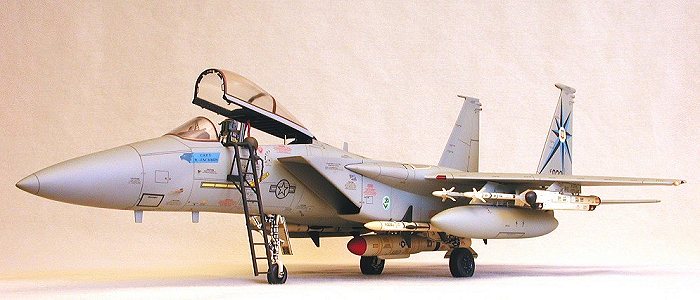
|
KIT: |
Monogram 1/48 F-15A Eagle |
|
KIT # |
5801 |
|
PRICE: |
$5.50 in 1979 |
|
DECALS: |
Three aircraft |
|
REVIEW & |
|
|
NOTES: |
Original issue |

|
HISTORY |
The McDonnell-Douglas F-15A Eagle was designed from the outset as a no-compromise air superiority fighter. During the Vietnam War the Air Force’s ‘jack-of-all-trades’ F-4 Phantom II, though a versatile platform, was found lacking in many crucial areas. Marginal maneuvering ability at low altitudes, limited rearward visibility, smoke-prone engines, and lack of an internal gun in the early versions conspired to handicap the F-4 in the ‘turn and burn’ dogfight arena that the skies over North Vietnam had become.
The F-4E was developed as a panacea to most of these shortcomings and the final slatted wing variant with its smokeless J-79 engines was exactly what the Air Force needed eight years prior. Despite these upgrades the fact of the matter was, the Phantom had reached its maximum in growth potential and no additional modifications or refurbishments would change that. After wading through reams of data gleaned from combat reports, Air Force tacticians began planning the specifications for a next generation fighter plane, the FX.
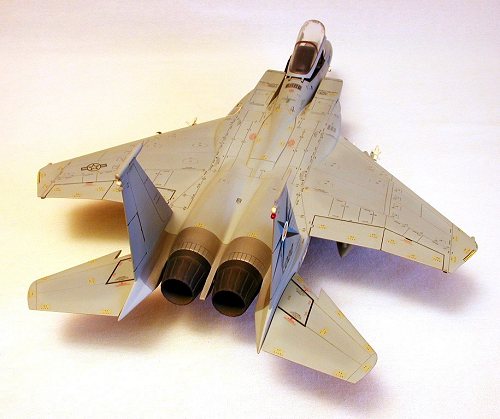 In a departure from the McNamara-inspired
‘multi-mission commonality’ of the Johnson administration, it was decided that
the new aircraft would be designed to fulfill the air superiority role only.
Not a pound for air-to-ground or so the adage went. Requirements
included low wing loading, maximum vertical acceleration, and a thrust-to-weight
ratio exceeding 1:1. 360-degree visibility was mandated for the single
crewmember, combined with a full spectrum of air-to-air weapons including radar
and infrared guided missiles plus an internally-fitted cannon. The new fighter
would be equipped with a zero-zero ejection seat and be Mach 2+ capable at
altitude.
In a departure from the McNamara-inspired
‘multi-mission commonality’ of the Johnson administration, it was decided that
the new aircraft would be designed to fulfill the air superiority role only.
Not a pound for air-to-ground or so the adage went. Requirements
included low wing loading, maximum vertical acceleration, and a thrust-to-weight
ratio exceeding 1:1. 360-degree visibility was mandated for the single
crewmember, combined with a full spectrum of air-to-air weapons including radar
and infrared guided missiles plus an internally-fitted cannon. The new fighter
would be equipped with a zero-zero ejection seat and be Mach 2+ capable at
altitude.
With the performance parameters fully delineated, the Air Force issued an industry-wide RFP in September of 1968. McDonnell-Douglas, North American, Fairchild Hiller, and General Dynamics all submitted proposals and all except the latter received design study and engineering contracts. Following an assessment of the individual proposals by Air Force Systems Command, McDonnell-Douglas was declared the winner fifteen months later.
Their FX proposal included a pair of second generation high-bypass afterburning F-100 turbofan engines from Pratt & Whitney, though teething problems with this untested powerplant plagued the program well after production aircraft were placed into service. Common maladies included compressor stalls and thermal fatigue. Refinements to the variable intake, afterburner, and fuel control systems eventually solved the stalling problems, while additional annealing of critical bearing and stator shaft components rendered them more forgiving of the higher ambient operating temperatures.
Initially the aircraft was to be equipped with the new Ford Aerospace-designed GAU-7 25mm cannon featuring caseless ammunition and linkless feed. Paradoxically, Ford’s ballistic engineers were never able to solve the dilemma of inadvertent round ‘cook-off’ and continuous high G maneuvers never failed to cause feeding problems. Ultimately this weapon was shelved prior to production, to be replaced by General Electric’s tried-and-true M-61A1 20mm system.
The heart of the new fighter’s weapons system was to be a new multi-mode pulse doppler radar with ‘look down-shoot down’ capability and full compatibility with current and projected IFF/SIF systems. Built by Hughes, this radar was designated the APG-63 and featured modular construction with line replaceable units (LRUs), to minimize downtime for maintenance and/or repair. Solid-state engineering throughout insured reliability under the harshest of conditions.
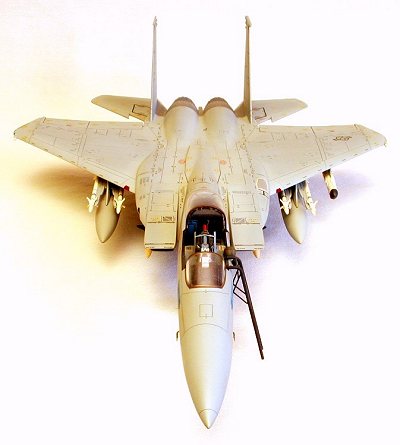 A Douglas IC-7 Escapac ejection seat with
‘zero-zero’ capability was specified initially. Well into production this unit
would be superceded by the ubiquitous McDonnell ACES II seat, by then a familiar
fixture in the A-10 and F-16 as well. Earlier aircraft would subsequently be
retrofitted with the ACES II during scheduled depot-level overhauls.
A Douglas IC-7 Escapac ejection seat with
‘zero-zero’ capability was specified initially. Well into production this unit
would be superceded by the ubiquitous McDonnell ACES II seat, by then a familiar
fixture in the A-10 and F-16 as well. Earlier aircraft would subsequently be
retrofitted with the ACES II during scheduled depot-level overhauls.
The prototype was completed and rolled out on the 26th of June 1972. Following a brief ceremony at Lambert Field in St. Louis the aircraft was named the F-15 Eagle and construction commenced on twenty pre-production prototypes for use in the flight test program. Two of these aircraft were twin-seaters designated the TF-15A and would later assume the role of test mules to explore advanced concepts in fly-by-wire and directed thrust technologies.
Early flight testing revealed some minor flutter problems so a dog-tooth was added to the stabilators to correct this, while the wingtips were recontoured to eliminate buffeting problems at high Alpha angles. To decrease final approach speed and landing rollout distance the speed brake was enlarged by fifty-seven percent.
By mid-1973 the design had been finalized and production was well under way. The Air Force accepted it first Eagle, a two-seat TF-15A, on the 14th of November 1974. The first planes were delivered in an overall air superiority blue paint scheme but this color was not particularly effective at masking or camouflaging the Eagle when airborne. Some tests were conducted with the angular ‘Ferris’ scheme but ultimately the Air Force adopted the two-tone Ghost Gray livery which is still in use today.
In January of 1975 F-15A 72-119 (the nineteenth production Eagle) was modified and used to recapture several time-to-climb records held by a Navy F-4B and the Russian MiG-25. No expense was spared in this attempt, to include gutting the aircraft of all military equipment and stripping the paint off. Three different Air Force pilots flew this F-15A from Grand Forks, North Dakota, establishing eight new benchmarks from 3000 to 30,000 meters from a standing start runway take-off.
Eagles entered regular service with the 1st TFW at Langley AFB, Virginia in January of 1976. Eventually five units would be so equipped plus the training wing (405th TTW) at Luke AFB, the 32nd TFS based in the Netherlands, and one squadron assigned to the 57th FWW at Nellis in Nevada. Following disbandment of the Aerospace Defense Command in 1979, Tactical Air Command assumed interceptor duty for the continental United States and NORAD. As 1950s-era F-101s and F-106s were retired many of those former ADC units were issued F-15s, including the 21st Composite Wing at Elmendorf in Alaska, the 57th FIS in Iceland, and the 318th FIS at McChord AFB in Washington. (And let us not forget the 48th FIS at Langley, and the 5th FIS at Minot. All these ADTAC units were under the control of the 1st AF. As an additional side note, the 43rd TFS of the 21st CW in Alaska was never a FIS or ADTAC unit though it basically performed that function. The last regular Air Force FIS unit to disband was the 57th FIS. Unlike the others, the 57th never flew the F-15A, going straight from the F-4E to the F-15C/D. It was no longer needed after the end of the Cold war and was gone some 5-6 years after the last stateside unit was disbanded. Ed.)
These ‘AD-TAC’ units continued to operate the ‘A’ model while the overseas-deployed wings began receiving the improved F-15C, starting in 1979. Surplus F-15As would eventually be overhauled and issued to Guard and Reserve units, replacing rapidly aging F-4s and the few remaining ‘Century Series’ fighters.
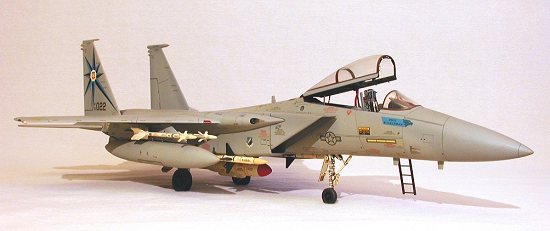 In the early 1980s the new Reagan
administration’s enhanced appreciation of space as the ultimate high ground
encouraged the Air Force to pursue countermeasures to the Soviet Union’s
reconnaissance satellite capability. Existing technology allowed the
development of a miniature exo-atmospheric vehicle able to destroy an orbiting
satellite, provided the missile were launched from an altitude of 80,000 feet.
The proven zoom-climb capability of the F-15 was ideally suited for this
purpose. Provisional plans envisioned two squadrons of specially equipped F-15s
based on either coast, with the 318th FIS selected as the West Coast
unit. (The 318th was actually quasi-operational on these missiles and
involved in a couple of test firings. The combination was a rather intriguing
set up. The ASAT (Anti-SATellite) missile was actually in control of the F-15
during the zoom portion of the mission, the Eagle being basically just a
booster. It was only when the F-15 stopped flying and was on the verge of
stalling in the thin atmosphere that the missile's on-board computer launched
the ASAT from the Eagle and allowed the pilot to regain control of his aircraft.
Ed)
In the early 1980s the new Reagan
administration’s enhanced appreciation of space as the ultimate high ground
encouraged the Air Force to pursue countermeasures to the Soviet Union’s
reconnaissance satellite capability. Existing technology allowed the
development of a miniature exo-atmospheric vehicle able to destroy an orbiting
satellite, provided the missile were launched from an altitude of 80,000 feet.
The proven zoom-climb capability of the F-15 was ideally suited for this
purpose. Provisional plans envisioned two squadrons of specially equipped F-15s
based on either coast, with the 318th FIS selected as the West Coast
unit. (The 318th was actually quasi-operational on these missiles and
involved in a couple of test firings. The combination was a rather intriguing
set up. The ASAT (Anti-SATellite) missile was actually in control of the F-15
during the zoom portion of the mission, the Eagle being basically just a
booster. It was only when the F-15 stopped flying and was on the verge of
stalling in the thin atmosphere that the missile's on-board computer launched
the ASAT from the Eagle and allowed the pilot to regain control of his aircraft.
Ed)
Ultimately, Congressional quislings in cahoots with their sniveling stooges in the Senate conspired to kill this vital capability by the stroke of a pen after several successful test launches. Many of these self-serving political pantywaists remain in office, as continual handicaps to yet-emerging military technologies (unless constituent jobs within their districts are at stake).
Eagles have been sold to Israel, Japan, and Saudi Arabia under the auspices of the FMS and MAP program. Prior to his ouster, the Shah Reza Pahlavi of Iran had expressed interest in the F-15 as well, though the Imperial Iranian Air Force ended up selecting Grumman’s Tomcat instead. Most US ‘A’ model Eagles have been replaced with the improved F-15C and rows of the earlier variant are parked at Davis-Monthan’s boneyard, their fate uncertain.
(Editor's note: The remaining in-service F-15As are MSIP II variants that are currently operated by at least seven Air National Guard units. The MSIP II planes have had updated electronic suites and are in many ways equal to if not superior to the current regular USAF F-15Cs, especially in the air intercept role. These planes are primarily FY(Fiscal Year) 75-, 76, and 77- year serialed aircraft that previously served with the 49th TFW at Holloman AFB or the 32nd FIS in the Netherlands, though some came from other sources as well. Except for the F-15B two-seaters, I believe all FY 73-, 74-serialed planes are in the bone yard providing needed spares. The F-15C version started with FY 78- serials).
|
THE KIT |
Monogram’s F-15A Eagle kit consists of seventy-six pieces molded in gray, five clear parts, and decals for three aircraft. The fold-out instruction pamphlet features a recommended assembly procedure, a painting guide with FS595a camouflage color specifications, and a brief history of the aircraft.
The airframe is broken down into right and left forward halves, an upper and lower main fuselage with the stabilators molded integrally, and two-piece wings which slide over large tabs on the upper fuselage to lend strength to the assembly. Surface detailing and panel lines are in raised relief and are generally correct with the notable exception of the ECS vents to the rear of the canopy. These are depicted as raised louvers when in fact they are recessed vents. The large gear doors are molded closed, correct for all production Eagles.
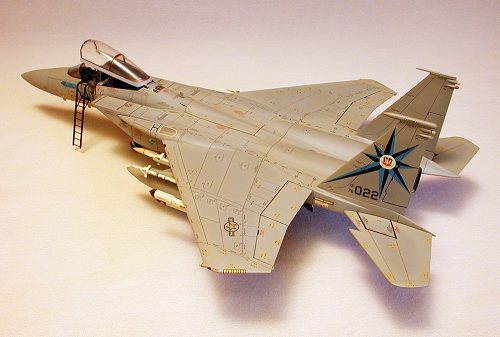 The cockpit
contains a main tub and a separate avionics bay. The instrument panel and side
consoles are molded in raised relief, reflecting an early ‘A’ model as
advertised. A nicely detailed control stick is furnished though throttles are
conspicuously absent. A murky Douglas Escapac seat is included, along with a
two-piece seated pilot figure and a standing crew chief.
The cockpit
contains a main tub and a separate avionics bay. The instrument panel and side
consoles are molded in raised relief, reflecting an early ‘A’ model as
advertised. A nicely detailed control stick is furnished though throttles are
conspicuously absent. A murky Douglas Escapac seat is included, along with a
two-piece seated pilot figure and a standing crew chief.
The landing gear offers robustly molded one-piece struts with clear parts for the landing and taxi lights. The tires appear correct in width and profile while the wheel hubs accurately reflect the early F-15A. A separate arresting hook may be attached in the deployed position.
Other optional features include a rudimentary representation of the APG-63 radar which is visible if the radome is attached in the ‘open’ position, a separate speed brake and actuator, the seldomly used built-in boarding ladder, and a two-position canopy. An embossed ‘F-15 Eagle’ plaque may be attached to a display base or diorama.
The tailpipes simulate the troublesome “turkey feathers” which would later be removed, while the multi-piece intake ducts have baffles at the rear of the by-pass ramps to prevent ‘see-through’. Vertical fins are correctly ‘handed’ with the properly configured tip fairings for each.
External stores consist of four AIM-7F Sparrow missiles, four AIM-9L Sidewinders, rails and wing pylons for the latter, a 600-gallon centerline fuel tank, and an early ALQ-119(V) ECM pod with integral pylon to attach under the outer wing panel. As an added touch, a well-molded muzzle assembly is included for the gatling gun.
The transparencies include a highly polished windscreen, canopy, and heads up display plus the aforementioned landing/taxi lights. The separate canopy frame may prove problematic when attaching the canopy itself, but generally fits well when assembled.
The decal offers three schemes: 77-100, an F-15A assigned to the 33rd TFW at Eglin AFB in Florida; 75-036, an F-15A serving with the 1st TFW at Langley AFB in Virginia, and sporting the moniker “The Tidewater Gator”; and an F-15A of the 32nd TFS based at Soesterberg AB, The Netherlands. Ample stenciling is included along with several ‘Remove Before Flight’ streamers to attach to the ordnance and landing gear. Thick and matte-finished, the decals are best replaced with aftermarket items.
|
CONSTRUCTION |
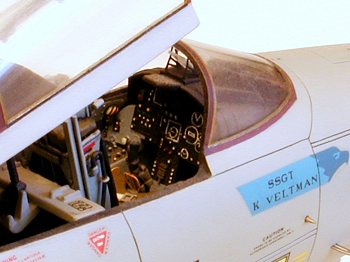 After mocking up
the major airframe components with masking tape to check for fit and accuracy
problems, I disassembled the model and removed both stabilators using my razor
saw. These would later be re-attached, using a pair of brass wire pins. Actual
assembly commenced with the forward fuselage.
After mocking up
the major airframe components with masking tape to check for fit and accuracy
problems, I disassembled the model and removed both stabilators using my razor
saw. These would later be re-attached, using a pair of brass wire pins. Actual
assembly commenced with the forward fuselage.
The cockpit and avionics bay were detailed, painted, then installed into the right fuselage half. Throttles were added to the left side console while missing LRUs for the avionics bay were fabricated from sheet styrene. The kit’s IC-7 Escapac seat was replaced with Verlinden’s resin ACES II. After adding the appropriate details from bits of wire, stretched sprue, and Plastruct ‘C’ channel, I painted the seat and installed lap and shoulder restraints. Belts were sliced from cigarette pack paper while Model Technologies provided the photo-etch buckles.
Aluminum tubing sockets were installed in the fuselage halves which would mount dual pitot tubes, AOA transducers, and temperature probes later in the build. I disregarded the radar pieces, electing instead to insert some ballast in the radome as insurance. MV lenses were used in lieu of the kit parts for the landing and taxi lights on the nose gear strut, then I glued this piece into the nose well. After attaching the assembly into the right fuselage, both halves were mated together and glued with Hot Stuff. The radome was attached them I sanded the seams smooth.
The ECS vents on
this kit are terrible but a fix was but a spares box drawer away. I once had
owned a Fujimi F-15A that had deliberately exceeded the maximum dynamic
structural load factor on its final ‘flight’ and catastrophically collided with
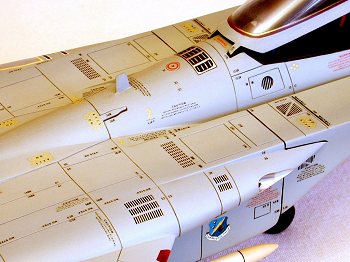 ¾” sheetrock. Among the numerous components recovered from the “crash site” was
the forward section of the fuselage containing the ESC vents. These vents were
much better looking and after squaring up this part I removed Monogram’s
interpretation and sectioned in the Fujimi vents. Voila, instant fix!
The numerous “whiskers” for the sockets were fabricated from steel wire,
straight pins, and hypodermic needles then I set the nose aside and moved to the
fuselage.
¾” sheetrock. Among the numerous components recovered from the “crash site” was
the forward section of the fuselage containing the ESC vents. These vents were
much better looking and after squaring up this part I removed Monogram’s
interpretation and sectioned in the Fujimi vents. Voila, instant fix!
The numerous “whiskers” for the sockets were fabricated from steel wire,
straight pins, and hypodermic needles then I set the nose aside and moved to the
fuselage.
I wasn’t thrilled with some of the molded vents over the intakes and gun fairing so these were all replaced with photo-etched stainless steel grills. The small strakes over the aft Sparrow missile mounts were replaced with .010” sheet aluminum, pre-shaped and installed through slots cut in the aft fuselage. I opened up all the various cooling scoops and vents on the bottom of the fuselage then attached the main gear wells. After gluing the speedbrake, on the upper and lower halves were mated with Crazy Glue.
 The gun fairing
is bisected by a seam which is impossible to sand away so I installed the
gatling gun at the rear of a piece of ¼” aluminum tubing and sleeved it into the
right forestrake. After gluing with gap-filling Hot Stuff the excess aluminum
was filed and sanded away with the proper amount of muzzle visible. Hypodermic
needles replaced the molded gun barrels prior to installation.
The gun fairing
is bisected by a seam which is impossible to sand away so I installed the
gatling gun at the rear of a piece of ¼” aluminum tubing and sleeved it into the
right forestrake. After gluing with gap-filling Hot Stuff the excess aluminum
was filed and sanded away with the proper amount of muzzle visible. Hypodermic
needles replaced the molded gun barrels prior to installation.
Bearings made from brass tubing were affixed to the aft fuselage extensions to support new brass wire mounts for the stabilators. The fairing between the tailpipes was boxed in with sheet styrene then I moved to the fins. A clear position light was added to the left side while a red anti-collision beacon was situated on the right. After rescribing the fins they were glued on using Testor’s liquid cement.
Surface detail was replaced on the nose and main fuselage then these assemblies were mated together with Crazy Glue. The intakes were then assembled and attached with a lot of shimming, trimming, and fiddling needed for an acceptable fit. A pair of intake covers would have solved a multitude of problems but I elected to just gut it out.
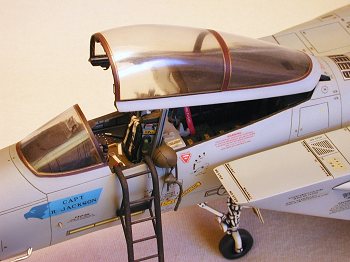 The wings were
next and after un-warping the right upper half, they were assembled and detailed
with position lights at the tips and anti-collision beacons inboard. Rescribing
proved to be a challenge due to the trapezoidal access panels. I made a
template for each out of .015” clear acetate which permitted visual positioning
for proper alignment. The wings attached well to the fuselage with the large
locating tabs eliminating dihedral problems.
The wings were
next and after un-warping the right upper half, they were assembled and detailed
with position lights at the tips and anti-collision beacons inboard. Rescribing
proved to be a challenge due to the trapezoidal access panels. I made a
template for each out of .015” clear acetate which permitted visual positioning
for proper alignment. The wings attached well to the fuselage with the large
locating tabs eliminating dihedral problems.
To replicate the polished metal in-flight refueling door on the left forestrake I cut away the plastic there and sectioned in a pre-shaped piece of aluminum sheet. The compound curves necessitated some additional sanding to render the door flush then I polished the area using my Dremel tool with a buffing wheel and Brasso. After attaching the main gear struts I painted the landing gear components and glued the wheels on. The stabilators were plugged in then I flew several test sorties in my studio.
The kit HUD was replaced by a photo-etched part and after folding and gluing it to the coaming I cut some rectangles of .005” clear styrene for the refracting glass. After painting the coaming I attached the windscreen, using white glue. When it had dried I removed the excess glue with a damp Q-tip then coated the joint with Hot Stuff. The white glue acted as an airtight gasket, preventing any chlorosis inside. When the CA cured I filed and sanded the seam flush then re-polished the windscreen.
I used the same
technique on the canopy and when it was done, I finished the assembly using the
Model Technologies
 photo-etched F-15 canopy detail set. The coiled defroster
cable was fabricated from stretched vinyl sprue left over from an earlier Tamiya AFV project. After heat-forming it in near-boiling water while wrapped around a
straight pin I cut it to length and affixed it with Crazy Glue.
photo-etched F-15 canopy detail set. The coiled defroster
cable was fabricated from stretched vinyl sprue left over from an earlier Tamiya AFV project. After heat-forming it in near-boiling water while wrapped around a
straight pin I cut it to length and affixed it with Crazy Glue.
A pair of brass wire pins were used to mount each Sparrow missile while new ‘C’ kickers were fabricated from 7/32” aluminum tubing and chrome-steel straight pins. A second drop tank was procured and both were separated from their integral fuselage pylons then re-attached to the wing pylons, again with brass pins. A quartet of AIM-9J Sidewinders from the Hasegawa ‘C’ set were adapted to fit the missile rails, then the rails too were glued to the pylons.
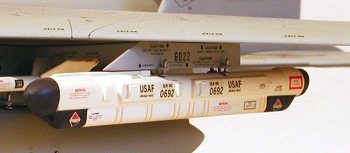 The ECM pod was
separated from its integral pylon and re-attached with a scratch-built set of
sway braces and steel wire pins. After a few test-fits the pod was removed and
the pylon was attached under the left wing. Note: Stations 1 and 9 were used
only briefly for carriage of countermeasures equipment. Use of these hardpoints
was discontinued in the early 1980s.
The ECM pod was
separated from its integral pylon and re-attached with a scratch-built set of
sway braces and steel wire pins. After a few test-fits the pod was removed and
the pylon was attached under the left wing. Note: Stations 1 and 9 were used
only briefly for carriage of countermeasures equipment. Use of these hardpoints
was discontinued in the early 1980s.
The ASAT missile
was a real challenge. I had several photos clipped from Air Force, the
Air Force Times, and Aviation Week & Space Technology but no
real specifications. I ended up scaling the missile to the model using the
photos, then sketching the missile through four views.
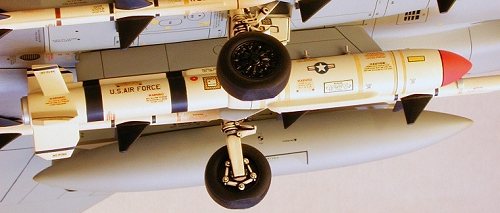 Different
drop tanks from my spares box were used for the body while the fins were
fabricated from sheet styrene.
Different
drop tanks from my spares box were used for the body while the fins were
fabricated from sheet styrene.
None of the photos revealed the missile’s mounting in any detail so I used the centerline pylon removed from one of the drop tanks as a starting point. After adapting it to fit the weapon, I added a pair of sway braces and mounting pins then glued the pylon to the fuselage. Numerous test-fits of the missile confirmed proper integration to the pylon and comparisons with my photos revealed I got it just about right.
Finally, the tailpipes were assembled and dry-fitted to the fuselage. After several minor adjustments I removed them and attached the arresting hook in the retracted position. Following a light sanding overall and a final inspection it was time to get the Eagle into a proper uniform… Off to the paint shop!
|
PAINT & DECALS |
After masking the finished exterior details and aft fuselage I wrapped tissue paper around the landing gear, stuffed the cockpit full of Kleenex, then sprayed the camouflage scheme using Modelmaster enamels. The rear fuselage was finished with a mix of Spray ‘n’ Plate titanium and stainless steel, while the ECS vents were painted with non-buffing aluminum. Pactra terra cotta, darkened with 34079 green, was used around the windscreen and canopy.
Gloss white was used on the missiles and ECM pod then those items were set aside to dry while I gave the model several heavy coats of gloss lacquer to prep the surface for decals. As the Glosscote cured I painted the tailpipes with flat black then burnished the exteriors with powdered graphite.
The model was decaled using SuperScale sheet 48-242. Stenciling came from combining SuperScale’s 48-063 and 48-261. This was one of those never-ending jobs, complete with panel numbers ranging to #193 (right and left). Ultimately, approximately 1000 individual decals were applied. To preserve my sanity I divided the operation into several manageable sections (wings, empennage, intakes, etc.) and worked over three weeks, a section at a time.
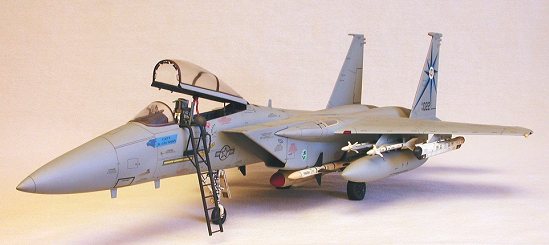 For reasons
known only to SuperScale, the eagle motif crew name blocks were left blank on
the decal sheet. I saw that an as opportunity so I “promoted” myself and added
my own name (hey, I did log 1.3 hours in the rear pit of a ‘B’ model!),
using Clarendon letters from an N-gauge MicroScale railroad sheet. A close
personal friend became my crew chief, dutifully reflected on the starboard side.
For reasons
known only to SuperScale, the eagle motif crew name blocks were left blank on
the decal sheet. I saw that an as opportunity so I “promoted” myself and added
my own name (hey, I did log 1.3 hours in the rear pit of a ‘B’ model!),
using Clarendon letters from an N-gauge MicroScale railroad sheet. A close
personal friend became my crew chief, dutifully reflected on the starboard side.
After cleaning the model to remove any Solv-a-Set residue I sprayed it overall with several coats of Testor’s flat lacquer. I ran an India ink wash into the vents, louvers, and control surfaces then used Liquitex watercolor on the landing gear struts. After sealing the weathering with more Dullcote I removed the remaining masks and brush-painted the RHAW antennas on the fins and wingtips with Modelmaster Radome Tan. The “whiskers” were plugged in at the front while the tailpipes were glued in aft with Testor’s liquid cement.
The Sparrow missiles were detailed with black fins and Radome Tan nose cones, decaled with bits from the spares box, then press-fitted onto their mounts. Likewise, the drop tanks were mounted to the pylons then I decaled the Sidewinders and glued them to the rails. These finished sub-assemblies were set aside while I detailed and attached the ASAT missile.
A bit of artistic license was used here as the resolution of my available reference photos was not that great. After painting the warhead cover red, I added the usual yellow trestle guides and black stripes using decals. Surplus stenciling was robbed from various sources, plus a pair of miniature national insignia. After around sixty decals I called it quits, Dullcoted the missile, then attached it to the pylon.
After decaling the countermeasures pod, the Sidewinder/fuel tank assemblies were glued to the wings with small drops of Crazy Glue, then I placed the sway braces onto the ALQ-119’s mounting pins and press-fitted the pod onto its pylon. Finally, the canopy was attached with its actuator and maintenance prop providing a cantilevered installation with the hinges.
As an afterthought I scratch-built a boarding ladder from aluminum tubing and stainless steel wire, then cut off the pilot’s head (!!!), hollowed out the helmet, added an oxygen mask and hose, and affixed it to the canopy rail with white glue.
|
CONCLUSIONS |
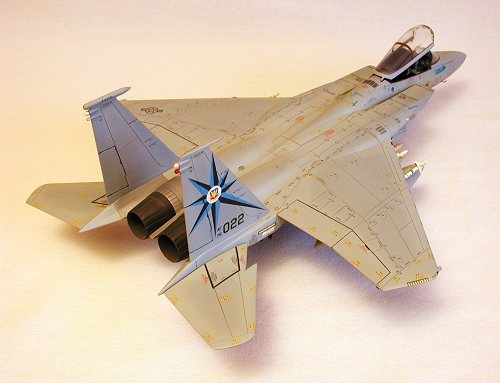 Monogram’s F-15A
was superceded in its catalog line-up several years ago by a slightly re-tooled
‘C’ model, featuring new sprues containing featherless tailpipes, ‘C’ style
wheel hubs, an ACES II seat, and some additional antennas. Beyond that, both
kits assemble in an identical fashion. The model’s lines and proportions scale
well with available multi-view drawings and the finished product really looks
the part.
Monogram’s F-15A
was superceded in its catalog line-up several years ago by a slightly re-tooled
‘C’ model, featuring new sprues containing featherless tailpipes, ‘C’ style
wheel hubs, an ACES II seat, and some additional antennas. Beyond that, both
kits assemble in an identical fashion. The model’s lines and proportions scale
well with available multi-view drawings and the finished product really looks
the part.
The problem areas of the ECS vents and slight warpage of the wings are easily remedied by modelers of average skill while anal retentives with AMS can avail themselves of the myriad of aftermarket upgrades and still remain below the threshold of Hasegawa’s prohibitively priced wunderkits. Despite its raised surface detail the Monogram F-15 is in some respects actually the more accurate model.
Neither this kit nor the later F-15C bear any resemblance to the recently released Revell-Monogram F-15E Strike Eagle. This model features all-new tooling and engineering, reflecting the latest advances in injection molding technology. Logical speculation on whether R-M will ultimately re-tool this kit into a proper state-of-the-art single-seater is inevitable but only market forces will determine that.
|
REFERENCES |
Modern Military Aircraft: Eagle – Lou Drendel, Squadron-Signal Publications
The F-15 Eagle: In Detail & Scale – Bert Kinzey, Kalmbach Publications
F-15 Eagle In Action – Lou Drendel and Don Carson, Squadron-Signal Publications
Tactical Air Command: A Pictorial History – Lou Drendel, Squadron-Signal Publications
Soaring Eagles: The McDonnell-Douglas F-15 – Jerry Scutts, Mallard Press
USAFE: A Primer Of Modern Air Combat In Europe – Michael Skinner, Presidio Press
Encyclopedia Of World Air Power – Bill Gunston, Crescent Publishing
Wings – Mark Meyer, Thomasson-Grant Publishing
Fighter Interceptors: America’s Cold War Defenders – Francillon, Lewis, and Dunn, Osprey
The History Of The US Air Force – Bill Yenne, Exeter Books
Ó December 2001 by Roger M. Jackson
First Time North American Rights To Scott Van Aken and ‘Modeling Madness’
If you would like your product reviewed fairly and quickly by a site that has thousands of visits a day, please contact me or see other details in the Note to Contributors.